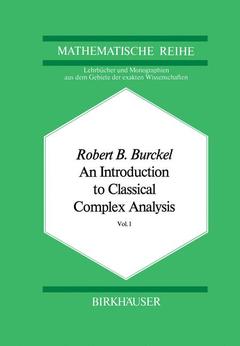0 Prerequisites and Preliminaries.- § 1 Set Theory.- § 2 Algebra.- § 3 The Battlefield.- § 4 Metric Spaces.- § 5 Limsup and All That.- § 6 Continuous Functions.- § 7 Calculus.- I Curves, Connectedness and Convexity.- § 1 Elementary Results on Connectedness.- § 2 Connectedness of Intervals, Curves and Convex Sets.- § 3 The Basic Connectedness Lemma.- § 4 Components and Compact Exhaustions.- § 5 Connectivity of a Set.- § 6 Extension Theorems.- Notes to Chapter I.- II (Complex) Derivative and (Curvilinear) Integrals.- § 1 Holomorphic and Harmonic Functions.- § 2 Integrals along Curves.- § 3 Differentiating under the Integral.- § 4 A Useful Sufficient Condition for Differentiability.- Notes to Chapter II.- III Power Series and the Exponential Function.- § 1 Introduction.- § 2 Power Series.- § 3 The Complex Exponential Function.- § 4 Bernoulli Polynomials, Numbers and Functions.- § 5 Cauchy’s Theorem Adumbrated.- § 6 Holomorphic Logarithms Previewed.- Notes to Chapter III.- IV The Index and some Plane Topology.- § 1 Introduction.- § 2 Curves Winding around Points.- § 3 Homotopy and the Index.- § 4 Existence of Continuous Logarithms.- § 5 The Jordan Curve Theorem.- § 6 Applications of the Foregoing Technology.- § 7 Continuous and Holomorphic Logarithms in Open Sets.- § 8 Simple Connectivity for Open Sets.- Notes to Chapter IV.- V Consequences of the Cauchy-Goursat Theorem—Maximum Principles and the Local Theory.- § 1 Goursat’s Lemma and Cauchy’s Theorem for Starlike Regions.- § 2 Maximum Principles.- § 3 The Dirichlet Problem for Disks.- § 4 Existence of Power Series Expansions.- § 5 Harmonic Majorization.- § 6 Uniqueness Theorems.- § 7 Local Theory.- Notes to Chapter V.- VI Schwarz’ Lemma and its Many Applications.- § 1Schwarz’ Lemma and the Conformal Automorphisms of Disks.- § 2 Many-to-one Maps of Disks onto Disks.- § 3 Applications to Half-planes, Strips and Annuli.- § 4 The Theorem of CarathSodory, Julia, Wolff, et al.- § 5 Subordination.- Notes to Chapter VI.- VII Convergent Sequences of Holomorphic Functions.- § 1 Convergence in H(U).- § 2 Applications of the Convergence Theorems; Boundedness Criteria.- § 3 Prescribing Zeros.- § 4 Elementary Iteration Theory.- Notes to Chapter VII.- VIII Polynomial and Rational Approximation—Runge Theory.- § 1 The Basic Integral Representation Theorem.- § 2 Applications to Approximation.- § 3 Other Applications of the Integral Representation.- § 4 Some Special Kinds of Approximation.- § 5 Carleman’s Approximation Theorem.- § 6 Harmonic Functions in a Half-plane.- Notes to Chapter VIII.- IX The Riemann Mapping Theorem.- § 1 Introduction.- § 2 The Proof of Caratheodory and Koebe.- § 3 Fejer and Riesz’ Proof.- § 4 Boundary Behavior for Jordan Regions.- § 5 A Few Applications of the Osgood-Taylor-Caratheodory Theorem.- § 6 More on Jordan Regions and Boundary Behavior.- § 7 Harmonic Functions and the General Dirichlet Problem.- § 8 The Dirichlet Problem and the Riemann Mapping Theorem.- Notes to Chapter IX.- X Simple and Double Connectivity.- § 1 Simple Connectivity.- § 2 Double Connectivity.- Notes to Chapter X.- XI Isolated Singularities.- § 1 Laurent Series and Classification of Singularities.- § 2 Rational Functions.- § 3 Isolated Singularities on the Circle of Convergence.- § 4 The Residue Theorem and Some Applications.- § 5 Specifying Principal Parts—Mittag-Leffler’s Theorem.- § 6 Meromorphic Functions.- § 7 Poisson’s Formula in an Annulus and Isolated Singularities of Harmonic Functions.- Notes toChapter XI.- XII Omitted Values and Normal Families.- § 1 Logarithmic Means and Jensen’s Inequality.- § 2 Miranda’s Theorem.- § 3 Immediate Applications of Miranda.- §4 Normal Families and Julia’s Extension of Picard’s Great Theorem.- § 5 Sectorial Limit Theorems.- § 6 Applications to Iteration Theory.- § 7 Ostrowski’s Proof of Schottky’s Theorem.- Notes to Chapter XII.- Name Index.- Symbol Index.- Series Summed.- Integrals Evaluated.




